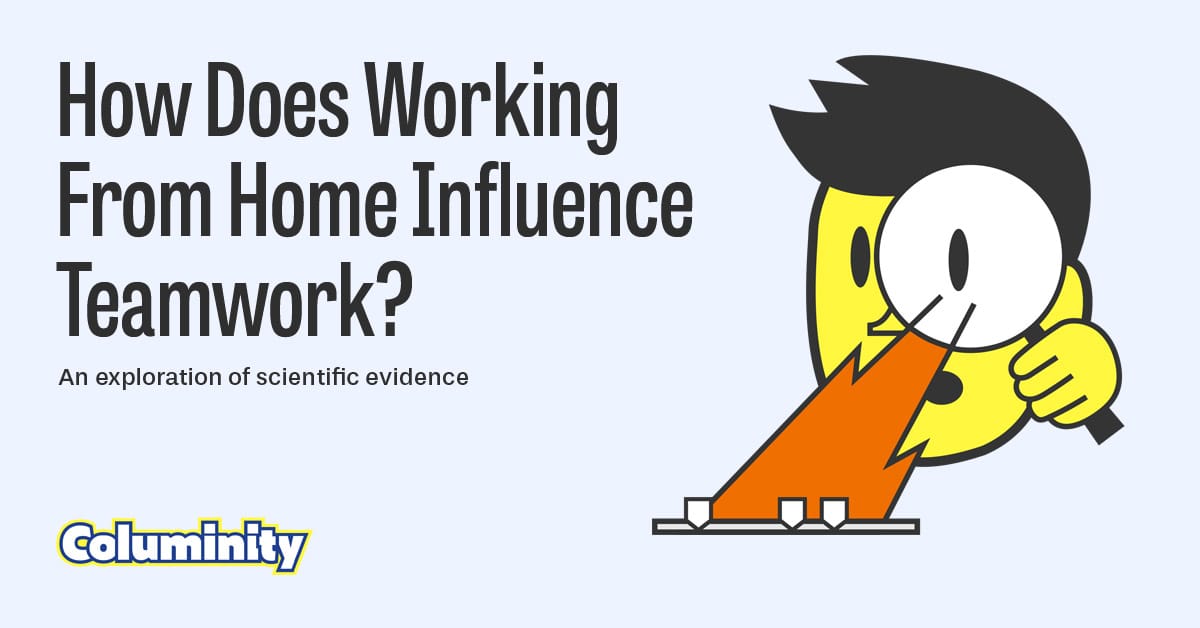How Does Working From Home Influence Teamwork?

Is working from home a good idea? When the COVID-19 pandemic hit, almost everyone suddenly had to work from home. But since then, many organizations have reverted back to requiring employees to be in the office. A common concern is that working from home harms teamwork and reduces the performance of individual workers and teams.
But what does the scientific evidence say? In this post, we review current scientific evidence around how working from home affects employees and teams and offer practical recommendations.
You can measure the effectiveness of your team(s) with Columinity. Go to highperformingteams.columinity.com to try. Our free plan is great for individual teams, but with a paid plan you can track many teams from a single dashboard.
Results from empirical studies
Van der Lippe & Lippényi (2019) conducted the most comprehensive study on this topic so far. Their research covered data from 9 countries, analyzing 259 organizations, 869 teams, and 11,011 employees. The study incorporated both self-reported employee performance and manager assessments of team performance. The findings indicated that remote work had a negative impact on both employee and team productivity. To put this in perspective, the authors stated: “If a team were to increase working from home by eight hours or more, the likelihood of a very good performance evaluation decreases by 70 percent as compared to teams in which no workers work from home.” Notably, this research was carried out before the COVID-19 pandemic.
Golden (2007) examined 240 professionals and discovered that employees who do not work remotely experience lower job satisfaction when their colleagues spend more time working from home. Additionally, those colleagues are more likely to seek other job opportunities. However, this negative impact diminishes when employees have a high level of autonomy in their roles.
Collins, Hislop & Cartwright (2016) interviewed 33 employees at a large governmental agency. Their findings suggested that remote workers feel increasingly disconnected from their in-office colleagues, and this effect intensifies the longer they work from home. On the flip side, the study also indicated that remote workers tend to develop stronger support networks with fellow remote colleagues. When employees primarily work from home, social cohesion with office-based coworkers tends to decline.

Vega, Anderson & Kaplan (2014) assessed the performance, satisfaction, and creativity of 180 professionals over five consecutive workdays, during which they alternated between working from the office and home (averaging 2.13 days remotely). The study found that remote work led to small improvements in self-reported job satisfaction and performance but had no impact on creativity. Another study by the same authors (2014) with 102 employees yielded similar results, revealing increased job satisfaction when working remotely. However, the effect varied depending on personality traits—employees prone to work-related rumination reported lower job satisfaction, whereas those with high openness or strong social networks outside of work reported greater job satisfaction.
Bloom et. al. (2018) analyzed a quasi-experiment at a major Chinese call center operator. In this study, 249 employees in a “treatment group” worked remotely four days a week and spent one day in the office, while their performance was compared to that of full-time office workers. The results showed a 13% productivity boost among remote workers, with 9% attributed to working longer hours (fewer breaks and sick days) and 4% linked to increased efficiency (fewer distractions at home). Additionally, job satisfaction was higher, and remote employees were less likely to leave their jobs. However, those working from home were passed over for promotions. A limitation of this study was that participants voluntarily opted into the remote work group, often due to lengthy commutes.
Lastly, Ramos & Prasetyo (2020) explored how a new remote work policy in the Philippines influenced productivity. Surveying 250 participants, they found that remote work led to higher job satisfaction and productivity without significantly affecting job stress. However, job performance did decline.
Empirical Studies during COVID-19
The studies discussed so far were conducted before the COVID-19 pandemic. However, the pandemic abruptly forced organizations of all sizes across many countries to transition to remote work. This shift created what could be considered the largest work-from-home experiment in history, prompting numerous researchers to examine its impact on individuals and teams. A key limitation of these studies is that any observed declines in productivity or well-being may not have been solely due to remote work but also influenced by the broader effects of the pandemic, including social distancing measures and increased anxiety.
Guler et al. (2021) surveyed 194 office workers during the pandemic and found that while employees reported higher productivity, they also faced physical challenges due to home office setups that lacked ergonomic chairs and desks.
Cucolas & Russo (2023) explored how remote work affects project success among 138 software developers. Their findings indicated that working from home had a positive impact on self-reported project success. This effect was even stronger when teams used an Agile framework, particularly Scrum, suggesting that its structured, recurring events helped improve coordination among hybrid and remote teams.
Another study by Russo, Hanel & Van Berkel (2023) tracked 192 developers across five measurement points during the pandemic. They found that productivity remained stable over time, but well-being declined. However, since this study was conducted entirely during the COVID-19 period, it is unclear whether the decline in well-being was due to remote work itself or the stress and uncertainty of the pandemic.
Finally, Farooq & Sultana (2022) surveyed 250 employees from various sectors in India and found that working from home had a negative effect on self-reported productivity.
In summary
So, what is one to make of these results? We begin with productivity and job performance. The studies by Vega, Anderson & Kaplan (2014), Bloom et. al. (2018), Guler et al. (2021), and Cucolas & Russo (2023) report improved productivity, project success, or performance. Ramos & Prasetyo (2020) shows that productivity increases, but performance decreases. On the other hand, Farooq & Sultana (2022) and Van der Lippe & Lippényi (2019) report lower productivity or performance. These mixed results are also reported in a literature review by Hackney et. al. (2022). From the 37 studies they reviewed before COVID-19, 79% reported increased productivity and performance, whereas 21% showed mixed or no effects. They also note that more studies reported adverse effects during COVID-19, with 23% positive, 38% no, and 38% adverse effects. These mixed findings suggest that context plays a substantial role. Some of the variables already identified are support structures, the number of other colleagues who also work from home, gender, and autonomy.
However, performance and productivity are one side of the coin. The other is the satisfaction of employees with their jobs. Here, the picture is much clearer. All studies investigating the link between working from home and job satisfaction reported a positive effect on job satisfaction. However, working from home may negatively affect the satisfaction of co-workers who do not work from home and lack autonomy (Golden, 2007), and social cohesion decreases (Collins, Hislop & Cartwright, 2016).
“All studies that investigated the link between working from home and job satisfaction reported a positive effect on job satisfaction.”
How working from home impacts teamwork
A limitation of most studies we reported in this post is that they focus on individual performance and satisfaction instead of teams and teamwork. Cucolas & Russo (2023)suggest that a team-based Agile methodology like Scrum can increase project success due to its focus on teamwork. Several studies suggest that social cohesion decreases when people work from home (Collins, Hislop & Cartwright, 2016), which fits anecdotal evidence. But to what extent working from affects teamwork, the productivity of teams, and what can be done to support teams remains largely unstudied.
Social cohesion
A clear challenge to working from home is the potential loss of social cohesion in teams. Group cohesion is a key variable of effective work teams (Hackman, 1987, Carless & De Paola, 2000). Social cohesion reflects the social realities of a team. Do members identify with each other? Do members identify as members of that team? Do members like being part of the team? More simply put, it reflects to which extent the team fulfills the social needs of people, such as being recognized by others and being part of something greater. Studies suggest that social cohesion encourages members to work together on tasks rather than apart (Zaccaro & Lowe, 1988). So any loss in social cohesion is likely to reduce the ability of teams to become (or remain) high-performing (Hackman, 1987).
Team cognition
Another perspective on teamwork originates from cognitive psychology. It treats teams as information processors (Hinsz, Tindale & Vollrath, 1997). Because each member brings their own cognitive resources (skills, viewpoints, preferences, capabilities), teams have to learn how to organize those resources and task-related information to work on shared tasks. This is called team cognition (DeChurch & Mesmer-Magnus, 2010). This is like a “team mind” that contains knowledge about “how things are done in this team”, like who has which skills, how members like to collaborate, what implicit steps members go through when they work on tasks, and so on. Such a team mind contributes clearly to team effectiveness (Kearny, Gebert & Voelpel, 2009). While the link between working from home and team cognition has not yet been studied to my knowledge, it will likely take a greater effort in teams where people either work partially or fully from home.
Mental health
Finally, working from home can influence mental health differently than working in the office. A literature review by Oakman et al. (2020) found that some studies report increased stress and fatigue, while others report lower stress and fatigue. Organizational support structures, gender, work-home policies, and the level of autonomy all seem to moderate this effect. Because working from home reduces commute time and leaves more time for other activities, most respondents report increased quality of life. On the other hand, employees often feel they have to be more visible when working from home (digital presenteeism) and work longer hours.

Practical implications
Based on the results, we will now develop several practical implications. Please note that the amount of evidence-based research in this area is still limited, so we will extrapolate from the evidence we have.
Strategy 1: Adjust policies to the type of work and individuals
If one thing is evident from these studies, it’s that the impact of remote work varies depending on multiple factors. Generally, working from home is more effective for roles that don’t require frequent collaboration or in-person interactions (Bloom et al., 2018). Additionally, individual differences—such as the need for social interaction, autonomy, or tendencies toward rumination—also play a role (Anderson, Kaplan & Vega, 2014).
When designing remote work policies, it’s important to consider these variables. Ideally, teams should have the flexibility to define their own policies, as they best understand their preferences, past experiences, and the extent to which in-office work is necessary for their success.
Strategy 2: Attract and retain employees by working from home
Remote work has been shown to enhance job satisfaction and overall quality of life, making it a valuable perk for both current employees and potential hires. In competitive job markets, companies that offer flexible work arrangements can differentiate themselves from competitors. This advantage can be further strengthened by providing strong support structures, such as ergonomic home office setups, virtual collaboration tools (e.g., Miro, Mural, and Zoom), coaching and training programs, and frequent social events.
Training is particularly crucial for managers, who may need to shift from a traditional top-down leadership style to a more supportive and facilitative approach (Hackney et al., 2022). Additionally, for teams with a high percentage of remote workers, investing in team-building activities is essential to maintain engagement and cohesion.

Strategy 3: Spend time on team building
As remote work becomes more common, teamwork dynamics are bound to change. Without intentional effort, teams may experience declines in social cohesion, task cohesion, and team cognition. To counteract this, organizations should proactively invest in team-building activities that strengthen connections and reinforce a sense of shared purpose.
These activities should focus on fostering a strong team identity, establishing shared norms and values, and creating meaningful team rituals. Specific examples of these approaches are provided in this post. Importantly, team-building should not be a one-time or annual event—it should be an ongoing process. Activities can be conducted both virtually and in person, ensuring that teams with frequent remote work continue to develop and maintain strong relationships.
Closing Words
During the COVID-19 pandemic, organizations worldwide had to rapidly transition to remote work. While many of these policies remain in place, there are growing signs that some companies are reverting to pre-pandemic restrictions on remote work, often based on the belief that it hinders teamwork and performance.
However, as the research outlined in this post demonstrates, the impact of remote work is far from straightforward. Some studies indicate productivity gains, while others suggest declines. What does seem clear is that remote work generally enhances job satisfaction and quality of life for employees. Unfortunately, comprehensive meta-analyses on this topic are still lacking, leaving us to rely on individual studies and limited literature reviews.
Despite the mixed evidence, it is reasonable to assume that, without proper support, remote work can weaken teamwork. Social and task cohesion may erode, and maintaining strong team cognition becomes more challenging without regular interaction. However, instead of rolling back remote work entirely, organizations can implement support structures that help teams remain high-performing in a hybrid or remote environment. Rather than attempting to force a return to old ways, companies that embrace and optimize remote work will have a competitive edge. Ultimately, employees will choose to work where they feel most supported—and organizations that fail to adapt may struggle to retain top talent.
You can measure the level of social and task cohesion for your team(s) with Columinity. Go to teamworkquality.columinity.com to try now. Our free plan is great for individual teams, but with a paid plan you can track this factor - and many others - across many teams in the same or different organizations.


